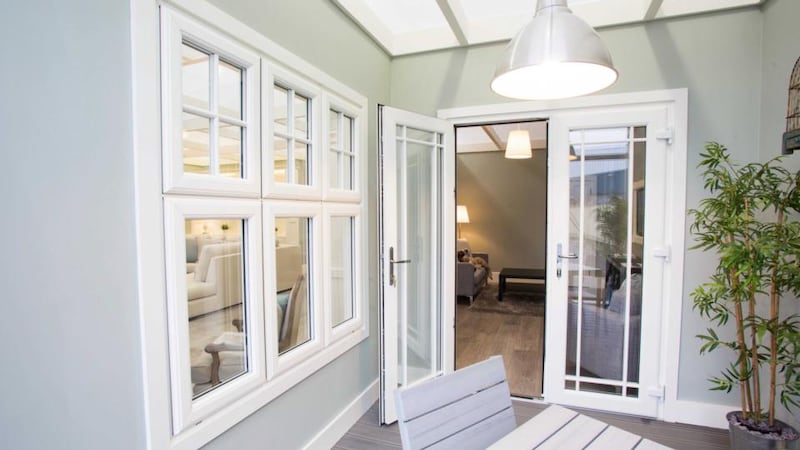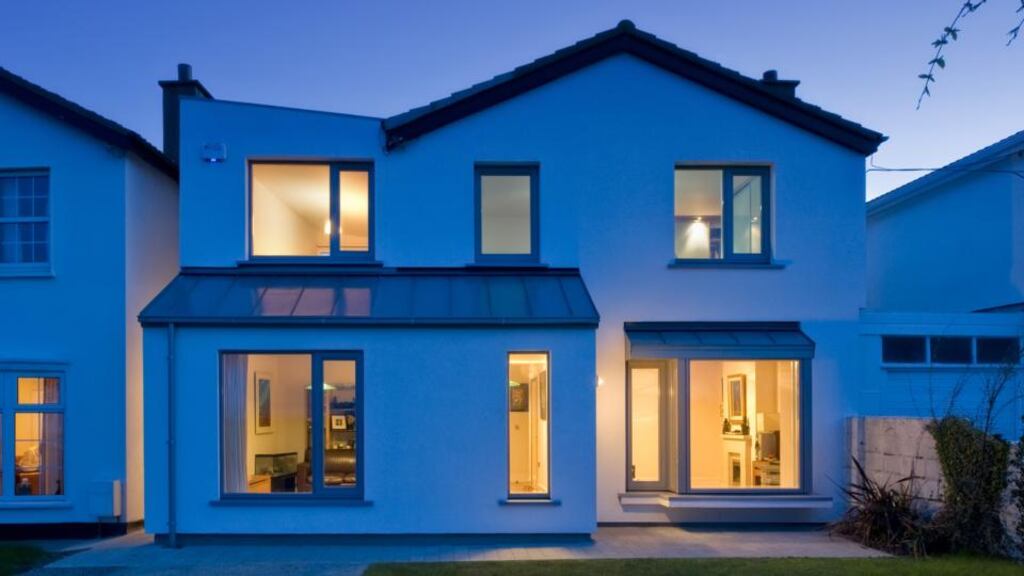‘Windows are very visible – people look at them as well as through them,” says architect Stephen Musiol of Small Spaces. Before buying, Ann Mooney of Marvin Architectural advises visualising the windows in situ or getting a CAD drawing from the supplier with windows inserted on the elevation.
Viewing a house with similar windows and checking CE certification, installation procedure and delivery dates are prudent steps, Mooney adds. “Ensure the company is reputable and query who warranties the product – the manufacturer or supplier?
“Consider longevity, aesthetic appearance and functionality. Windows are usually a lifetime proposition,” she says. New innovations may also influence decisions. Fairco has launched what it hails as Ireland’s first guaranteed burglar-proof windows. Rooflights, Musiol says, should be remembered for the potential impact they can have on daylight.


In a typical three or four-bed semi-detached house with a decent front door, patio or sliding door, back door and six standard windows and two or three smaller-sized ones, budget approximately €10,000 for supply and fit of good quality uPVC windows and doors.
Expect to pay €14,000 for the same in alu-clad, with factory timber somewhere in the middle, Musiol says. “Cheap grade uPVC can be had for less, but the quality suffers a lot.”
Generally uPVC is cheapest, offering a wide range of suppliers and generally a quick turnaround, he says. A good range of finishes and colours is available, with low maintenance required in the short to medium term.
But Musiol warns it’s a case of buyer beware. “Good quality uPVC windows aren’t that much lower cost than timber. uPVC is an environmentally-nasty material. Frames can be very bulky and junctions can be awkward. Also it’s impossible to repair or maintain uPVC once it’s damaged or worn.”
Timber appeals for its environmental sustainability. “It has low embodied energy and is a renewable material. A draw is the beauty of the material, if exposed. Versatility is another plus – when sourced from skilled suppliers, virtually any design can be made.
“Timber has a very long lifetime if maintained – there are timber windows in perfect working order that are hundreds of years old,” Musiol says. Mooney advises seeking the Forest Stewardship Council (FSC) label.
Maintenance with exterior paint over its lifetime is required or timber will be vulnerable to the elements. “Factory supplied timber windows probably need no attention for five to 10 years after installation,” Musiol says. “A longer lead-in time is involved, especially with bespoke elements or with windows supplied from abroad.”
Alu-clad is more expensive than uPVC or timber, and there are fewer suppliers, according to Musiol.
“It usually takes eight weeks from order to arrival and requires coordination when part of a small building project, and can add weeks to the job’s duration,” he says. A key advantage, Mooney says, is that it’s maintenance-free.
Aluminium is modern looking and can be detailed to be very elegant, with a wide variety of colours offered, Musiol says. However, it’s not common for domestic projects, with fewer suppliers, he says.
Finishes
uPVC comes in various colours and textures, including timber effect. “Timber can be left with exposed grain; naturally weathered, for certain types of timber; painted in any colour; or stained to various shades,” Musiol says.
With alu-clad, the timber side has the same selection of finishes and the aluminium side can come in any hue, he says. “Aluminium can come in any colour and can be anodised, which can give very high quality and durable finishes.”
Energy performance
Triple-glazing is becoming standard practice and argon gas infill, low-e coatings and warm spacers have all been introduced, Musiol says.
Many older windows, particularly aluminium, have very poor thermal performance, but replacing windows as an energy-saving measure should only be done after attic insulation; draught elimination, particularly through chimneys; and ensuring hot water cylinders are well insulated, he says.
There are ways of improving energy performance without ripping out original windows or glass, says Musiol. For historic windows, he advises contacting the Irish Georgian Society, the architectural conservation officer in your local council, or local conservation architects. The RIAI’s accreditation system and register facilitates searching by skill.
Restoration
Original, traditional windows in period properties are valuable and frequently irreplaceable, Musiol says. “The glass in many old windows is something of real value and quality, and is impossible to make nowadays.”
Lots of refurbishment options are available for traditional windows, including sliding sash windows, Musiol says. John Kirwan of Laois-based Clock Tower Joinery advises getting a survey done on existing sash windows. “In many cases they can be restored, resealed and double-glazed.
“The average cost of a restored single- glazed sash window is about €400 to €500. For double-glazed sash windows, expect to pay approximately €800 to €900,” says Kirwan, who also restores and manufactures casement windows.
Original windows in listed buildings may be protected, Musiol says. “Your house may be in an architectural conservation area, in which case there might be restrictions on replacing windows and planning permission might be required,” he says.
“There are more recent period window types that also deserve to be recognised as valuable and efforts made to preserve them. These include 20th-century steel windows, which can be incredibly delicate and have a huge proportion of glass relative to frame size.”
Regulation
For replacement of windows in existing houses, set u-value standards have to be achieved. Generally the standard for new windows would be well in excess of this limit, says Musiol.
“It may well be the case that moving beyond the regulatory minimum may be enough to affect the BER energy rating. It might be worth getting the figures looked at, particularly if you have the calculation already done.
“For new windows in new builds and some extensions, it’s not a set figure that determines the required u-value but a more complex calculation that needs to be worked out by someone competent. New build regulations for windows takes account of their part in overall energy performance, and also of solar gain,” Musiol says.
Regulations govern the amount of ventilation that spaces require and this has an impact on sizes of opening sections of windows, he says. “You can be fairly sure that a pure glass box extension will not and cannot comply with current building regulations. Ask for proof if you really want to go there. Conservatories have a get-out clause, but they have to be separate from the house – they can’t be permanently open to the other spaces.”
Regulations also govern where safety glass is required. “Generally, if a part of your window is within 800mm of the floor level, it needs toughened safety glass,” says Musiol.
Homeowners, he says, should be aware of the requirement for the opening sections of windows to be large enough to be used as fire escapes.










